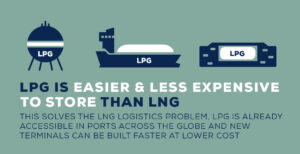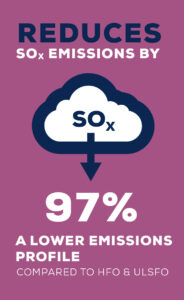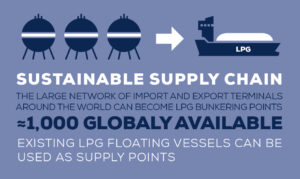Towards sustainable shipping with LPG by James Rockall, CEO & Managing Director, WLPGA
 Shipping is the lifeblood of the global economy and an essential part of all major supply chains. According to the International Chamber of Shipping, within the European Union alone, shipping accounts for 80% of imports and exports by volume, and globally the value of shipping trading is over 14 trillion US$ per year. Yet the sector is coming under increasing scrutiny regarding emissions. Like all other forms of transportation that burn hydrocarbon fuels for energy, marine transportation results in polluting emissions. Of these, sulphur dioxide, nitrogen oxides and particulate matter are dangerous for the environment and human health, while greenhouse gas emissions, such as CO2 and methane, contribute to climate change. Although transport by ship is by far the most energy-efficient form of freight transport, the International Maritime Organization (IMO) estimates that shipping accounts for about 3% of global greenhouse gas emissions. Given the current growth rates, shipping could well represent up to 10% of all global emissions by 2050 if nothing is done. There are many pathways to lowering shipping emissions, including operational, ship design and fuel choice. LPG is a unique, exceptional energy and when it comes to decarbonising shipping, LPG has an important and growing role to play.
Shipping is the lifeblood of the global economy and an essential part of all major supply chains. According to the International Chamber of Shipping, within the European Union alone, shipping accounts for 80% of imports and exports by volume, and globally the value of shipping trading is over 14 trillion US$ per year. Yet the sector is coming under increasing scrutiny regarding emissions. Like all other forms of transportation that burn hydrocarbon fuels for energy, marine transportation results in polluting emissions. Of these, sulphur dioxide, nitrogen oxides and particulate matter are dangerous for the environment and human health, while greenhouse gas emissions, such as CO2 and methane, contribute to climate change. Although transport by ship is by far the most energy-efficient form of freight transport, the International Maritime Organization (IMO) estimates that shipping accounts for about 3% of global greenhouse gas emissions. Given the current growth rates, shipping could well represent up to 10% of all global emissions by 2050 if nothing is done. There are many pathways to lowering shipping emissions, including operational, ship design and fuel choice. LPG is a unique, exceptional energy and when it comes to decarbonising shipping, LPG has an important and growing role to play.
Transported and stored as a liquid, but consumed as a gas, LPG can deliver cleaner, lower emission marine transport than many alternatives currently available. As an example, compared to Heavy Fuel Oil (HFO) which is commonly used in marine engines, LPG demonstrates a 97% reduction in SOx, 90% lower particulate emissions and a 20% reduction in NOx. In addition, compared to HFO, LPG can reduce greenhouse gas emissions by nearly 25%. These benefits are already recognised with LPG being the most commonly accepted alternative fuel in the world today. Although perhaps better known for fuelling passenger vehicles on roads, LPG can also be used in all sizes of marine vessels, from the largest ocean-going ships to smaller boats with inboard or outboard engines. Currently over 100 LPG fuelled VLGCs (very large gas carriers) are on order and this entire global segment is likely to fuelled by LPG within the coming decade.
A major consideration in marine transport is cost of operations. Fuel is a substantial part of annual ownership costs, representing up to 25% of the total and in this regard, solutions for reducing greenhouse gas emissions need to be carefully evaluated against their impact on shipping competitiveness. LPG has a significant advantage over other options for several reasons. Firstly, every country in the world already consumes LPG in a wide range of applications. This enables fast and low-cost LPG bunkering in ports anywhere on the planet. It is estimated that more than 1,000 such facilities already exist, significantly reducing the barrier to fuel switching. LPG can also be a retrofit solution which means that existing vessels using diesel or HFO can be converted at modest cost to achieve significant emissions reductions.
As many countries in the world pursue deep decarbonisation targets, there is a growing move towards lower, and ultimately zero emissions shipping. Driven by the IMO, carbon intensity of shipping is set to be reduced (compared to 2008) by 33% in 2025, 40% in 2030 and at least 70% by 2050. The pathway to achieving these deep cuts for an LPG-fuelled vessel is becoming clearer as near-zero renewable LPG (rLPG) is being developed. Suitable as a drop-in fuel into existing fuel systems, the promise of rLPG provides a future-proof solution for shipping owners.
But what of other options? What is clear is that to meet the 2050 targets and beyond, LPG (and rLPG) has many advantages. It provides most of the positive benefits of natural gas while having zero methane leakage and far lower infrastructure costs. LPG conversion of existing marine engines is simple and relatively low-cost while being easier and less expensive to compress, ship, and store than LNG. Electricity, long seen as a solution for light duty vehicles is an impractical solution for shipping since green electricity is being developed much too slowly and the current cost and weight of batteries is prohibitive. Other fuel options such as hydrogen and ammonia, while undoubtedly representing important future options, are currently unattractive due to technical challenges.
Our world is becoming increasingly low-carbon and all sectors of the economy need to address emissions. In the shipping sector LPG should be the fuel of choice for many vessels. Why? Because with its low emissions and low cost, LPG is the ideal fuel for quickly improving the environmental performance of ships. There are no technology barriers to overcome with LPG-fuelled propulsion systems and LPG bunkering is already widespread across the world. LPG is already a low-carbon, low-emissions fuel, but with the advent of renewable LPG, low-cost deep decarbonisation of the shipping fleet can be a reality.
James Rockall, CEO & Managing Director, WLPGA
About LPG as a Marine Fuel
LPG/Propane, is increasingly being used in marine engines in various types and sizes of vessels, from small leisure crafts with outboard engines, to fishing boats, patrol boats and larger vessels. It is an efficient marine fuel, it reduces exhaust emissions and eliminates the risk of fuels spills on the water. All information related to LPG as a Marine Fuel can be found on this page: Marine - WLPGA


